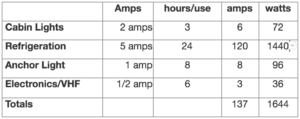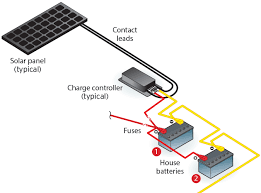For cruising sailors or those who keep their boat on a mooring or at anchor, keeping batteries charged can be a never-ending problem. When under sail, you must run the iron horse for at least 30 minutes a couple of times per day to maintain the power needed for critical systems. When on the hook away from shore power, the electrical requirements for lighting, bilge pumps, and refrigeration can drain batteries very quickly.
A practical and convenient solution for this issue; one we are helping more and more of our ![]() customers with, is marine solar power. Through our partnerships with Bruce Schwab Energy Systems and Coastal Climate Control, we are able
customers with, is marine solar power. Through our partnerships with Bruce Schwab Energy Systems and Coastal Climate Control, we are able ![]() to specify, install and warranty the latest panel offerings from Solara and Solbian as well as controller offerings from Blue Sky Energy, Genasun, and Victron Energy.
to specify, install and warranty the latest panel offerings from Solara and Solbian as well as controller offerings from Blue Sky Energy, Genasun, and Victron Energy.
When it comes to marine solar power, the key considerations boaters need to work through are how much power is required for their unique situation, what type of panels are best for your use and vessel and, finally, how will the power be stored.
How much power do you need?
For long-distance cruisers to be absolutely self-sufficient, it is generally recommended that a solar system should be capable of delivering approximately twenty percent in excess of the basic requirements to operate their vessel. To make this calculation, you must add up your average ampere-hours of DC consumed in a 24-hour period by the various systems in your vessel. This should include everything that consumes DC current: instruments, lights, VHF, pumps, refrigeration, etc.
By way of example, this simple chart can illustrate some of the amperage use and equivalent watts for common electrical equipment on a boat:
To calculate wattage, you multiply your amps by 12 volts. Three hours of cabin light usage, at 6 amps, would equal 72 watts. The total usage of 137 amps in this example, multiplied by 12 volts, would equate to a daily usage of 1,644 watts.
After estimating your average power consumption, the next step is to determine the type of solar panels which will match your power and installation requirements.
Which type of panel is best?
This question should actually be, which type of solar panel is best for your unique requirements. To get at this, consider the following: how much room do you have for panel installation? How powerful is the sun where you will be sailing?
There are three common types of solar cells used in solar panels sold today, each with their own advantages. This may start to get a little technical, but if you are going to make thoughtful determinations about your solar power, you need to understand the types of panels available and the key characteristics of each. A key consideration here is sensitivity to shading because, obviously, solar panels rely on the sun to create energy. Some solar modules factor in partial shading by including a diode between every string or cell.
Monocrystalline are single silicon cells grown into larger crystals, then cross-section cut into small wafers to form individual cells that are later joined to form a solar panel. This cell type has a very high conversion efficiency which translates into less surface requirements (and less space on deck).
Multicrystalline (Polycrystalline) are also single silicon cells constructed by utilizing multiple amounts of smaller crystals to form a cell. This cell type has high conversion efficiency.
Amorphous silicon is produced by depositing an active silicon material on various substrates such as stainless steel. The conversion efficiency is not as good as the single-crystal type, they are bulkier but work better in shaded situations and are the most inexpensive to manufacture (and therefore purchase).
Installation
In general, the best areas for mounting a panel are usually aft: on an arch, on top of dingy davits, on top of the bimini, between two stanchions, or on a pole on the rail. Your preferred mounting location will also be a factor in the type of panel you chose. For example, flexible panels can attach to the top of your bimini or dodger canvas.
Take your time and think this through; the best place depends on the configuration of your boat as well as the size of the solar panel or panels may determine the best mounting. It’s also key to follow manufacturer instructions during installation so as not to do anything which will violate the warranty (some of these products carry 20-year warranties so you want to be careful here).
The next consideration is linking the solar bank to your batteries. Here you use a charge  controller, making sure the proper setting for either gel or wet batteries is set. The wiring leading from your panels to the controller should be tinned marine grade; automotive wire looks similar to marine initially but after a few months in the marine environment it will lose conductivity, rendering your carefully thought-out array less efficient. You should also consider including a voltmeter in your system to monitor performance (if this is not included with your charge controller).
controller, making sure the proper setting for either gel or wet batteries is set. The wiring leading from your panels to the controller should be tinned marine grade; automotive wire looks similar to marine initially but after a few months in the marine environment it will lose conductivity, rendering your carefully thought-out array less efficient. You should also consider including a voltmeter in your system to monitor performance (if this is not included with your charge controller).
In closing, there is a reason we are seeing more and more solar installations these days. The price is heading in the right direction and it feels good not to have to rely on the noisy, smelly auxiliary a couple times a day to keep the batteries topped off. Contact us if you are interested in learning more.


